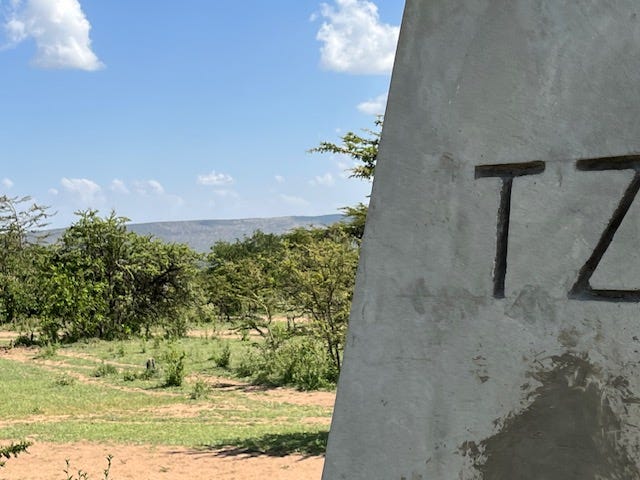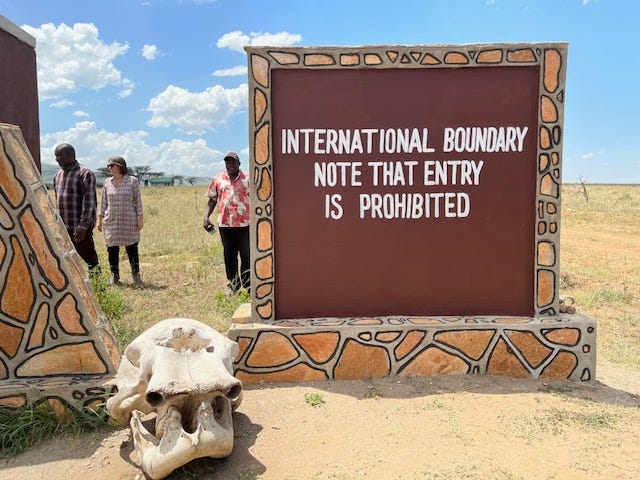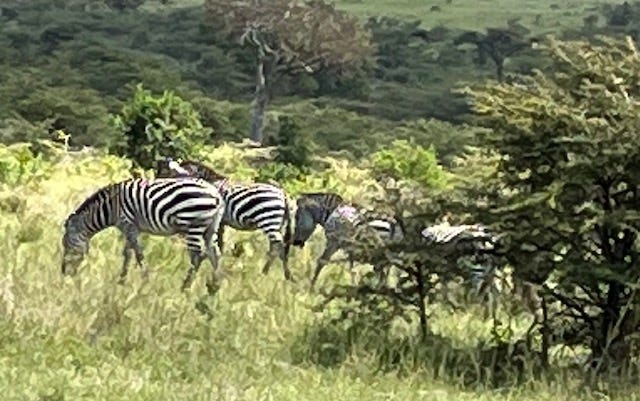When I first saw the giraffe, it was on the Tanzanian side. We were rumbling down a dirt road that ran right by the border. Before us appeared a large white beacon that marked the division between Kenya and Tanzania. At that moment, a giraffe was sauntering across the border. I asked Peter Ole Narok, the driver, to stop the car. I wanted that photo. But a series of clumsy events got the best of me. First, I couldn’t get out the door. Then I couldn’t get my phone unlocked. By the time I was ready to take the shot, the giraffe had disappeared behind some bushes.
But I soon learned that the place where we had stopped was far more significant than a giraffe crossing. The Maasai elders I was traveling with, Meitamei Olol Dapash and Donkol Ole Keiwa, jumped out of the green Land Rover and pointed to the recently created dirt road behind the marker. That’s the “Otterlo border,” they said.

The wide dirt road, pockmarked with patches of grass, seemed innocuous. But it was a big deal. Keiwa pointed to the tire tread on the ground amid other prints, such as those from the giraffe.
“They were here yesterday,” Keiwa said, referring to the police.
“Patrolling this border?” I asked.
“Yes.” Mentioning the police brought a hint of trepidation. Keiwa, Meitamei, and Peter—in the many humanitarian aid trips they had made to the area in 2022—had seen firsthand what the police are capable of.

The Otterlo border is a kind of subborder that runs north–south along the international boundary but doesn’t cross it, remaining on the Tanzanian side. It has caused one of the world’s least covered border and refugee crises.
But before I talk about that, let me back up for a second. We were driving along a remote part of the Kenya-Tanzania border near where the Serengeti meets the Maasai Mara National Reserve. Meitamei and Keiwa work for the Kenyan-based Dopoi Center, as does historian Mary Poole from Prescott College. Peter—our driver—is a part of the Mara Guide Association, the first labor association organized by the Maasai people in Kenya. We were there so they could show me the border, how remote it is, and how you can’t legally cross it into Tanzania—there are no ports of entry. This, an area known as Loliondo located before the Serengeti, was where a refugee crisis unfolded last June, and they were some of the first on the scene providing humanitarian aid.

They called it the Otterlo border after the Otterlo Business Corporation, a private company based in the United Arab Emirates that was trying to create a “wildlife corridor” for its trophy hunting and elite tourism enterprise.
In January 2022, the Tanzanian government announced it would lease 580 square miles to the Otterlo company. But this was Maasai community land where about 70,000 people lived in about 15 different towns. According to reporting on Mongabay, Maasai leaders were told by the regional commissioner that the land was of “national interest” to Tanzania because of its potential tourism revenue. The independent policy think tank the Oakland Institute called this “fortress conservation,” given that conservation was also used to justify the project. In February 2022 the Tanzania Wildlife Authority set up border beacons demarcating the wildlife corridor, but it was forced to leave after community members confronted its enforcers, perhaps setting the stage for what was to come.
If you were wondering, the U.S. border is also implicated here.The Tanzania Wildlife Authority had been trained, at least once, by the U.S. Border Patrol, as I mentioned in the first installment of this series. Also, a January 2022 article in CBP’s publicationFrontline, titled “Fighting the Ivory Trade,” discusses how CBP brought Tanzanian police officers to El Paso to learn about the agency’s canine programs and to train their dogs to sniff out ivory and drugs. Although the scope and impact of the trainings remain unclear, this border and its policing units bear the fingerprints of the United States’ broader global border apparatus. Around the world, border control is peddled like an evangelical virtue, and even this area—however remote—was not immune.

In June the Tanzanian government sent in the anti-riot Field Force Unit. The cops then proceeded to violently evict the local Maasai community to make way for the Otterlo company. Via Tanzanian refugees who began to flee across the border, word got to the Dopoi Center, where Meitamei is director and Keiwa director of language and culture. They quickly organized a small caravan to deliver humanitarian aid. This was June 14.
Right before we saw the giraffe at the Otterlo line, we were at the exact place where the humanitarian caravan first arrived on that day. The Maasai refugees described a chaotic scene, bordering on warfare. According to their descriptions, the police came with guns and live ammunition. They burned down houses, and people, including children, fled into the wilderness. One woman was gored by a buffalo. The first people Meitamei and Keiwa came across were children, hungry and shivering, looking for refuge.
Everybody had stories about what was happening. The police also came with machetes. The photos Meitamei showed me of the aftermath were so gruesome that I had to look away (the link above will take you to the photos on Meitamei’s Facebook page). Gashed ankles and legs. One picture showed a man with a gash so big, you could see his spinal cord.
They took us to the very tree where they had passed out food and provided medical attention, which often involved driving people to a clinic 40 kilometers away. If the Tanzanian police caught any of the humanitarian aid caravan crossing the border, they would arrest them. So they wore shukas (a red-and-black striped blanket worn by many Maasai), spoke Maa, and blended in with the locals. It was a border story with a different twist, an international boundary that shielded police operations, along with a new and aggressive subboundary created at the behest of a private company.
So at the Otterlo border where we stood, you could see the pain of returning to the scene bubble up into Meitamei and Keiwa’s expressions. The road had not been there before, but it now represented the takeover of 40 percent of the Maasai community land by the June and July police operations, according to Meitamei.
The situation, in other words, was still live. About half a mile before arriving to the border, we had met some women at a stream who told us that yes, “Suluhu is still trying to kill us,” referring to Tanzanian president Samia Suluhu Hassan. We also met a young woman on the Tanzanian side who was tending to her sheep and cows. She said the police were around the day before. She told us you can’t cross the Otterlo line, or they will shoot your cows, or shoot you. There was a feeling among the Maasai community in Tanzania that the police would be coming for more. Meitamei told me they “wanted this line 37 kilometers that way,” pointing into the horizon, past more communities where we saw houses and people in the distance.

While we were talking to the young woman, a herd of cows she was tending crossed the border into the Kenyan side, and she had to go bring them back. As she walked away, Keiwa exclaimed to us that he knew her family. In fact, they were relatives. He said it with a sense of exuberance and joy. Then, he looked down at the international boundary line, which he calls the colonial border, and said, “They can’t stop us from being relatives.” At the same time, one has to think that the Otterlo border—and the nexus between private corporations, the state, and boundary building it represents—has other plans for this young woman and her future.
This first appeared on The Border Chronicle.